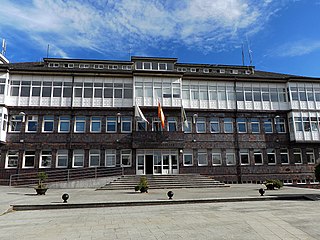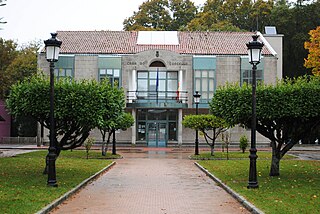
Galicia is an autonomous community of Spain and historic nationality under Spanish law. Located in the northwest Iberian Peninsula, it includes the provinces of A Coruña, Lugo, Ourense, and Pontevedra.

Celanova is a municipality in the province of Ourense, in the autonomous community of Galicia, Spain. It belongs to the comarca of Terra de Celanova. Situated near the border with Portugal, the municipality is bordered by Ramirás, Cartelle, A Merca, A Bola, Verea and Quintela de Leirado.

Vigo is a city and municipality in the province of Pontevedra, within the autonomous community of Galicia, Spain. Located in the northwest of the Iberian Peninsula, it sits on the southern shore of an inlet of the Atlantic Ocean, the Ria de Vigo, the southernmost of the Rías Baixas. It is the capital of the comarca of Vigo.

A Coruña is a city and municipality in Galicia, Spain. It is Galicia's second largest city, behind Vigo. The city is the provincial capital of the province of A Coruña, having also served as political capital of the Kingdom of Galicia from the 16th to the 19th centuries, and as a regional administrative centre between 1833 and 1982.

Lugo is a city in northwestern Spain in the autonomous community of Galicia. It is the capital of the province of Lugo. The municipality had a population of 100,060 in 2024, making it the fourth most populous city in Galicia.

Tui is a municipality in the province of Pontevedra, in the autonomous community of Galicia, Spain. It is located in the comarca of O Baixo Miño on the right bank of the Miño River, facing the Portuguese town of Valença. The municipality of Tui is composed of 11 parishes: Randufe, Malvas, Pexegueiro, Areas, Pazos de Reis, Rebordáns, Ribadelouro, Guillarei, Paramos, Baldráns and Caldelas.

Monforte de Lemos is a town and municipality in northwestern Spain, in the province of Lugo, Galicia. It covers an area of 200 km2 and lies 62 km from Lugo. As of 2017 it had a population of 18,783.

Cambre is a municipality in the Province of A Coruña, in the autonomous community of Galicia in northwestern Spain. It is located 12 km from the capital city of A Coruña and ten minutes away from the city's airport, Alvedro.

Carballo is a municipality in the province of A Coruña, in the autonomous community of Galicia, in northwestern Spain. The town is the thirteenth most populated municipality in the region and it belongs to the comarca of Bergantiños, serving as its capital.

The Minho or Miño is the longest river in the autonomous community of Galicia in Spain, with a length of 340 kilometres (210 mi). It forms a part of the international border between Spain and Portugal. By discharge volume, it is the fourth largest river of the Iberian Peninsula after the Douro, Ebro, and Tagus rivers.

Melgaço is a municipality in the district of Viana do Castelo in Portugal. The population in 2011 was 9,213, in an area of 238.25 km2. It is the northernmost municipality in Portugal.

Vilalba is a municipality in the province of Lugo, in the autonomous community of Galicia, Spain. It belongs to the comarca of Terra Chá. It is located on the left bank of the river Ladra, one of the headstreams of the Miño.

Castro de Rei, is a municipality in the province of Lugo, in the autonomous community of Galicia, Spain. It belongs to the comarca of Terra Chá. The population in 2009 was 5,685 people according to INE.

Friol is a municipality in the Lugo province in Galicia. It is located in northwest Spain. It is bordered on the north by Begonte and Guitiriz, to the south by Palas de Rei and Guntín, to the east by Lugo and Outeiro de Rei and to the west by the province of La Coruña. It has an area of 292.29 km2. It has a population of 3,616 inhabitants according to the INE in 2024. The population density is 12 inhabitants/km2.

Vilasantar is a municipality of northwestern Spain in the province of A Coruña in the autonomous community of Galicia. It belongs to the comarca of Betanzos.

Palas de Rei is a town in the province of Lugo, Galicia in northwestern Spain. It belongs to the comarca of A Ulloa.

O Saviñao is a Concello (council) in the province of Lugo, Galicia belonging to the district of Terra de Lemos. The main town for the council is Escairón.

Ribeira Sacra is a Spanish Denominación de Origen Protegida (DOP) for wines located in the south of the province of Lugo and in the north of the province of Ourense, in Galicia, Spain. It extends over the territories of 20 different municipalities that make up a zone also called Ribeira Sacra, which could be translated as "Sacred Riverbank". Vineyards are planted on the steep slopes of the valleys and canyons of the rivers Miño and Sil. The area acquired official Denominación de Origen status in 1996.

A Coruña or Corunna, Galicia (Spain) is located on a promontory in the entrance of an estuary in a big gulf, the Portus Magnus Artabrorum, name of the area used by classical geographers.
The Labio Castle, near Lugo, Spain, is famous in the context of the beginning of the 11th-century Viking nobleman Ulv Galiciefarer fighting against Galician-Leonese king Bermude III.























